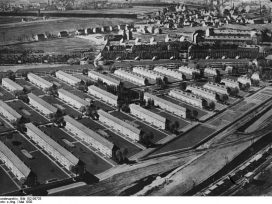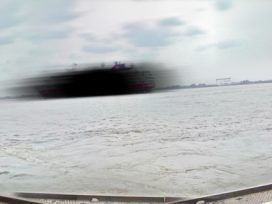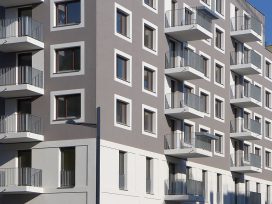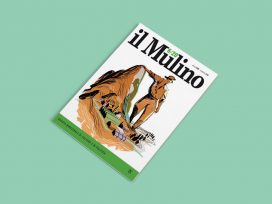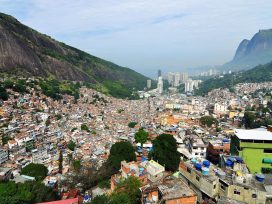I live in Marseille. I may not be a native, but I have lived there for fifteen years, and have developed an interest in the city, especially the harbour, which seems best understood not as a single zone but a plurality of spaces. Indeed the port conveys a vast array of ideas and experiences that will not merge into a single unit. On the contrary, as an open door offering access to the vast, old city of Marseille, its significance is forever unstable. Inasmuch as historic Marseille has an identity at all, it is a fluctuating, and controversial one. The city defines itself as Phocaean, founded by people who came from over the sea twenty six centuries ago. Virtually nothing of its supposedly glorious past remains visible, but this in itself is a good illustration of the way Marseille has adapted to a complex and changing reality. Sometimes called the “ancient city with no antiquities”, Marseille acquired ruins and remnants of a Greek past only a decade or two ago. Before that, its ancient features were the subject of local narrative rather than any testimony of its origin.
Marseille between idea and reality
Every morning a small fish market opens on the waterfront in Le Vieux Port. It consists of blue stalls full of fish, octopus and crab. Some of the catch can be extremely lively and flips around so much that at times the fish escape from the basin where they are stacked and drop onto the floor. This fish market is undoubtedly the most famous, known and cherished feature of the city. Any journalist reporting on Marseille begins by interviewing the fishermen and presenting the images and sounds of the market, as though some deeper truth about the “real” Marseille were rooted there, and as if the fishermen were custodians of vital secrets accessible only to themselves.
This apparent consensus on the representative quality of the fish market in no way reflects underlying reality. On the contrary, the fish market is a place of highly contrasting, even conflicting, images. No-one can be certain of the quality of the catch or where it is sourced. Some people swear it is the perfect place to buy fish, while others warn that it is the last place you should go. Some fish are certainly alive, but wily stallholders also combine living fish with dead ones in ways that make it impossible to see the difference.
Visitors also present a range of contrasts: tourists, the elderly, people out for a stroll, habitués, customers, and – early in the morning – cooks from local restaurants. In general, the fishermen take a pretty poor view of anyone other than a real customer. They may be considered “typical Marseillais“, but they dislike the urban authorities, and especially fact that the city uses the attractive image of a fish market for publicity while refusing to support to their trade.
Finally, the fish market represents the picturesque side of the city. It combines tradition, good food, the “typical Marseillais”, sea, tourism, and enjoyment. This image may be accurate in some respects, but it also conceals another, very real and tough side to life in Marseille, especially the harsh economic and social conditions in the port autonome, that is to say the isolated industrial and freight harbour to the north of the city.
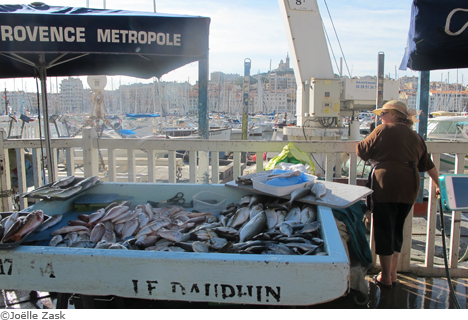
The fish market appears on the one hand as the iconic representation of a dreamed culture, and on the other, as a hub of conflicting ideologies and interests. In fact, the mismatch between idealized images and the reality is not an exclusive attribute of Le Vieux Port. It is a general feature of an urban space which Émile Témime, the most famous historian of Marseille, described as a city caught between adverse images: diversity and insecurity, migration and danger, welcome and rejection, integration, prostitution, official economic activities and the harbour “mafia” – none of which have close connection to the facts. According to Témime, Marseille is not even primarily a migration site: the number of migrants who have remained in Marseille is low compared to the millions that have simply passed through it – either to escape France, particularly during the Nazi period, or to reach another destination in Europe. Marseille lies in the main transit zone which once held a number of refugee camps, notably the well-known camp du Grand Arenas which hosted thousands between 1944 and 1966, including Vietnamese; Jews from Central Europe and North Africa; French families; and gypsies. It is also known as a gateway to freedom from the Nazi and Vichy regimes, for Marseille did a great deal to protect fleeing people, notably by hiding them before they could embark on a boat – whether to North Africa, where many Jewish families from Algeria, Morocco or Tunisia travelled, or to America, which was the destination for thousands of others. The role played by “the American Schindler”, Varian Fry, is well known. As an American journalist, he rented a bastide (a huge, traditional Provencal house) called La Villa Bel Air in Marseille. There he hid more than 2000 Jews, political opponents, artists, intellectuals and scientists over a period of 13 months, beginning in August 1940. The fact that the Nazis destroyed parts of the Old Port and an area named Le Panier, close by is no coincidence. On 22, 23 and 24 January 1943, with the help of the French police directed by Rene Bousquet, the Nazis conducted identity checks on 40,000 people, arrested 2,000 Marseillais Jews who subsequently died in extermination camps, and destroyed 1,500 buildings.
The fish market is a good way to address Marseille, for it works like an emblem of the dual reality that is, that is my view, characteristic of this harbour city. Indeed Marseille is a place where there is a satisfying degree of togetherness without any single unified vision of the city, or its past. It is a place where the conflicting narratives of diverse populations do not prevent relatively peaceful co-existence on same territory. Episodes of rejection and racist crime were recorded in the 1960s and 1970s but they appear anomalous rather than representative of the local situation. Marseille has never been a zone of major racial or ethnic warfare. Contrary to the widespread view that Marseille is a “Rio on the Med” – a city of violence, murder, delinquency, and high insecurity – its conditions are not worse than those of most large cities. Even organized crime, rampant in recent years due to territorial wars between mafia “barons”, seems considerably less powerful than in Chicago, Naples, New Orleans, or Rio de Janerio. At the ethnic level, we do not find in Marseille the kind of violent and extensive riots provoked by religious, racial or ethnic enmity that have occurred since the 1990s in Paris, London, Lyon, and even sometimes in small French towns like Strasbourg, Avignon, Montbeliard, Nimes, Villiers-le-Bel, or Grenoble.
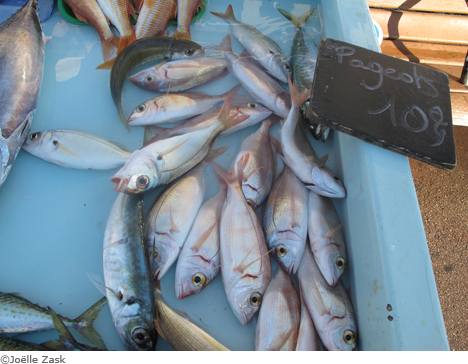
Mixité as state ideology
The example of the fish market raises questions about the need for a culturally unified narrative and, more generally, the need for unity in politics. Is a homogeneous culture a pre-condition for a shared mode of living? Must the sharing of territory, values, or expectations with regard to public behaviour be based on a uniform conception of life?
Today, these questions are especially pertinent. In Marseille, as elsewhere in France, many people believe that some populations, especially those of Arabic and Muslim origin, are intrinsically unable to assimilate into mainstream society. This leads either to xenophobic behaviour, or campaigns in favour of limited immigration. The argument is that a good society is one in which minorities embrace the majority culture and abandon their special features. In so doing they reinforce unity, without which the country would either implode into conflict or cease to exist as a national union. Instead of a nation we would see a range of small, disparate ethnic, racial and religious groups which ignore one another other and share nothing in common. This anxiety used to be expressed by the term “balkanization”.
We tend to think that a good culture or a good city should be unified, and any differences within it – harmonized. In France we may not expect cultural purity, natural ethnicity, and orthodoxy, but we don’t like people and groups that stay aloof and don’t mix. What we want is social fusion, a merger, adjustment, in-breeding, the melting pot. We have a profound dislike of people who don’t want to discard their native culture. We prefer assimilation to integration. We don’t want hyphenated people.
Consider what happened with American and Canadian communitarianism. In the 1980s, this was a political theory that challenged the liberal vision of the self and the idea of a community reduced to open, rational social contracts. It was promoted by political theorists such as Charles Taylor, Michael Sandel, Alasdair MacIntyre and Michael Walzer, by way of criticism of the Rawlesian theory of justice. Yet in France communitarianism quickly became communautarisme and lost its political meaning. It came to signify a social movement seeking repli identitaire (identity withdrawal): a growing disdain or hatred of the common good in favour of local allegiances. Alongside the new focus on “cultural identity” was a growing tendency to claim that “cultural identity” as such did not exist, but only self-invented identities and constructions related to economic interests. The withdrawal of cultural communities was a withdrawal into nothing.
Nevertheless, the Marseille fish market is clearly related to another set of urban experiences. Obviously, the harbour is the site of highly varied activities carried out by extremely varied people. Here you can meet citizens of Marseille, tourists from international cruise liners, professional beggars, travellers, would-be artists, small-time dealers, people of many different cultural origins. They may not mix, but they do not fight. They enjoy the cultural plurality without dreaming of more intimate connections. They don’t expect unified discourse or a single image of what is going on here, and they don’t need it for seeing, loving, crossing, sharing, or talking about the Old Port.
The same applies to the city as a whole. Far from being a melting pot, it is more similar to a mosaic or a stratified formation of groups. Communities do communicate, most of the time, but they do not merge. In Marseille, we have strong cultural feelings with no major cultural conflict. Italians, Armenians, Vietnamese, Jews, Algerians, Tunisians, Provençaux, Spanish, Greeks, Lebanese, Marseillais themselves with their bouillabaisse and panisse – in one way or another, all have maintained strong cultural commitments. Some have an active relationship with their own culture, as is the case for Jews and Armenians who, as well as practising their religious life, organize festivals, journals, conferences, trips, schooling, music, theatre and so on. Other groups with a more conservative culture and deep historical roots prefer celebration to innovation. The perception that cultural habits and beliefs merit dedication, care and love, can have far-reaching consequences, and may help prevent identity disorders in people from minority cultures who feel relegated to some kind of lower, less evolved form of life.
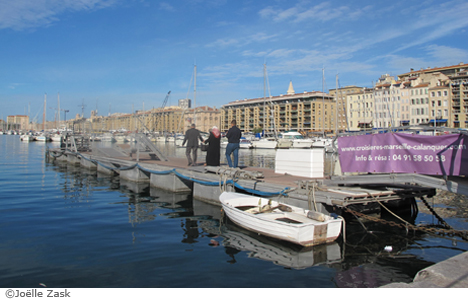
Another kind of good society
Marseille draws attention to the possibility of a good society based upon simple co-presence, rather than intimate coexistence. Today, the harbour is a symbol of what is good about a co-presence free of moral expectation or any specific political outlook on the issue of assimilation. People mix, or do not mix, for reasons that are far beyond the control of any politician. It is not a matter of goodwill and enlightenment, but of economic and cultural opportunity. When politicized will, the social melting pot becomes vulnerable to coercion. Looking back, we know how harsh and unfair national assimilation policies have been in the past. We must not undervalue the individual pain and psychological trauma that accompanies the renunciation of a language or traditional cast of mind, which forms part of one’s self-perception, world view and personality. As social scientists in the United States and elsewhere have demonstrated, we must not undervalue the usefulness of well-integrated ethnic cultures for the future integration of migrants into the society where they and their families have been received. These are just a few reasons why a project to support co-presence seems more congenial to democratic habits and beliefs, and more likely to bring social reconstruction in the long term, than a project to impose coexistence in the name of common interest and national unity.
Co-presence is not as diminutive as it may sound. It implies a society in which everybody is indeed present and therefore neither invisible, neglected nor rejected. Presence relies upon the ability of individuals to act, to produce some significant changes in the environment, to exert influence on the conditions of their life and so on. Presence means praxis. Anyone who does not contribute to the transformation of a shared environment does not count. He is absent and invisible. Yet presence relies also upon recognition from others. Whatever form refusal of this recognition may take (denial, lies, scorn, or rejection) it is clear that, when confronted with it, the individual who perceives himself as a co-actor can develop doubts about his ability to interact with others. Like a victim of trauma, he may even begin to doubt the reality of his own experiences.
Marseille may not be a perfect social environment – but nor is it a nightmare. It has features that should encourage us to consider the value of a multicultural society, free of any hope or fear that it is expected to arrive at a state of unity. Far from being compatible with liberal democracy, hopes for assimilation rather than integration represent democracy’s most dangerous aspect. The dissociation of nationality and citizenship is a vital task that must be addressed. It also invites us to value and appreciate what may appear to be a community of strangers – the real community that Europe clearly represents.
